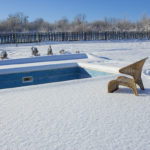10 tips for swimming pool maintenance in winter
The harsh elements of swimming pool maintenance in winter can really take their toll on different parts of the home and the backyard pool is no exception.
If you’re planning to switch off pool equipment during winter to save money on electricity and chemical costs, think again, swimming pool maintenance is still very important even in winter.
Not only will you run the risk of damaging expensive filtration and sanitation systems, but you could also damage your pool’s design.
10 tips for keeping home swimming pools in tip-top condition as the weather cools.
1. Clean the pool
Brushing the walls and floor, and then vacuuming the whole pool every couple of weeks helps prevent icky algae from forming. Clean the skimmer baskets and the pump’s lint basket of leaves to also ensure the filtration system works efficiently.
2. Balance pool water
The pool’s pH level needs to be between 7.2 and 7.6, which you can easily check by taking a water sample from elbow deep and adding the appropriate treatment to bring the pool to the correct level.
3. Clean the filter
Ensure that the pool’s filter is regularly cleaned, as any grease or oil deposits will harden over winter and make the filter even harder to clean in the warmer months.
4. Check chlorine levels
To keep your pool clean and clear, it’s important to maintain your pool’s free available chlorine at a constant level of 2-3 parts per million (PPM) throughout winter. If you’re using a salt chlorinator and a pool blanket, remember to reduce the output of the chlorinator to 1-2 PPM, as pool blankets trap chemicals and chlorine, and can cause high chlorine levels to occur – potentially damaging pool equipment if not monitored carefully.
5. Use a shock treatment
Regularly ‘shocking‘ your pool helps remove organic and inorganic wastes (referred to as chlorides), which includes sweat, sun cream, bird droppings and dead bugs.
It also ensures that the sanitiser can concentrate on killing bacteria and algae instead of these contaminants. Once you’ve added the shock treatment appropriate for your pool, run both the pump and filter for several hours to ensure it has been evenly distributed throughout the pool.
6. Remove algae as soon as you see it
When there is an algal bloom, most of the sanitiser in your pool is used trying to control and kill the algae, leaving no residual to keep pool water clean and healthy.
7. Reduce filter-running times
The pool’s filter should operate three to four hours each day during winter. If you’re using a timer, adjust it to suit. You can save money by switching the filter on during off-peak periods.
8. Set your solar heater to ‘Winter Mode’
If you don’t have an automatic controller on your solar pool heating system, manually switch it to Winter Mode or switch it off completely if you’re heading out of town.
9. Use your pool cover
Roll out the pool cover when you’re not using the pool to help keep leaves and other organic material out of the water. This means less cleaning for you and less food for algae and bugs to feed on – win, win! Pool covers and blankets also help minimise chemical evaporation – saving you time and money.
10. Keep up your maintenance schedule
Once you’ve done the full winter prep as outlined above, it’s important that you keep to a weekly maintenance schedule even when you’re not using the pool.
This involves doing a visual inspection to make sure all of your equipment is working properly, checking the water level and topping up if necessary, emptying the skimmer basket, and checking your chlorine and pH levels.
Remember, when it comes to swimming pool maintenance, a bit of work every day will save you A LOT of work one day.

